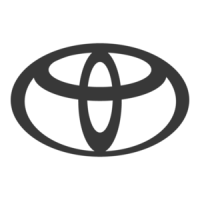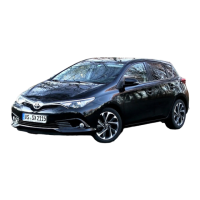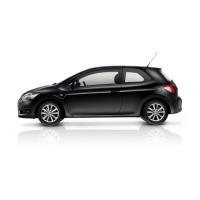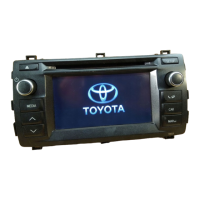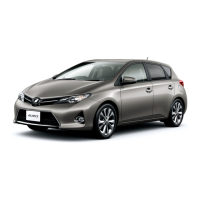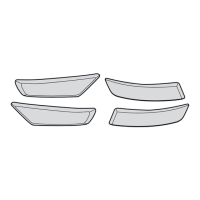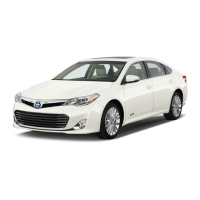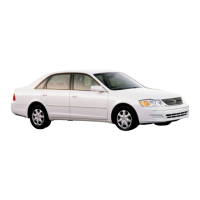Do you have a question about the Toyota AURION and is the answer not in the manual?
Warnings are provided throughout the manual to prevent injury or damage.
Explains the meaning of the safety symbol used for warnings.
Explains the function and operation of occupant restraint systems for maximum benefit.
Details master and sub keys, their functions, and transponder chip usage.
Explains types of keys and precautions for transponder chip keys.
Describes the components and functions of the smart entry and start system.
Explains the theft prevention system using an electronic code in the key.
Describes the operation and functions of the wireless remote control transmitter.
Details how to lock and unlock doors using the remote control and key.
Discusses general seating posture and precautions for occupants.
Details safety precautions for driver and front passenger seats regarding airbags.
Lists precautions related to side airbags installed in the seats.
Provides precautions for adjusting seats while the vehicle is moving.
Lists precautions for proper seatbelt usage, including for children and pregnant women.
Describes the function and components of seatbelt pretensioners.
Explains the purpose and operation of front airbags.
Details the function and safety precautions for side and curtain airbags.
Lists precautions and recommendations for using child restraint systems.
Explains how to select and install child restraint systems correctly.
Shows the locations of child restraint anchor fittings and their use.
Explains operation of headlights, turn signals, and automatic light control.
Lists messages displayed for vehicle status and actions required.
Explains the meaning of various warning lights and buzzers.
Details the operation of the engine start/stop button system.
Guides on using the automatic transmission, including S mode and engine braking.
Explains the function and operation of the traction control system.
Describes the integrated control of stability and traction systems.
Details the controls for the automatic air conditioning system.
Explains the parking assist-sensor system for aiding parking.
Discusses fuel types, octane numbers, and fuel tank capacity.
Provides safety precautions related to engine exhaust fumes.
Explains the procedure for starting the engine.
Provides the normal starting procedure for vehicles with a standard ignition switch.
Explains the starting procedure using the push button start system.
Lists simple checks to perform if the vehicle fails to start.
Guides on troubleshooting slow engine cranking, checking battery.
Offers solutions for when the engine cranks but doesn't start.
Explains the emergency start procedure for vehicles with smart entry.
Provides instructions for safely jump-starting a vehicle's battery.
Provides steps to take if the engine stalls while the vehicle is in motion.
Explains what to do if the vehicle's engine overheats.
Details the procedure for changing a flat tyre.
Provides step-by-step instructions for changing wheels.
Provides instructions for emergency towing when professional service is unavailable.
Advises on procedures if keys are lost.
Outlines steps to take if the wireless remote control is lost.
Explains common causes of corrosion and necessary cleaning measures.
Lists symptoms that indicate the vehicle needs service or repair.
Lists essential safety precautions for performing DIY maintenance.
Details how to check the engine oil level correctly using the dipstick.
Guides on checking the engine coolant level in the reservoir.
Explains how to check the brake fluid level and add fluid if necessary.
Stresses the importance of proper tyre inflation and how to check it.
Details how to check tyre tread wear and replace tyres.
Explains how to replace wheels, including wheel selection and balancing.
Provides precautions and emergency measures for battery handling.
Explains how to check fluid levels in battery cells and add distilled water.
Lists precautions to be taken when recharging the battery.
Details how to check for blown fuses and replace them correctly.
Provides tyre sizes and cold inflation pressures for various loads and speeds.
Warnings are provided throughout the manual to prevent injury or damage.
Explains the meaning of the safety symbol used for warnings.
Explains the function and operation of occupant restraint systems for maximum benefit.
Details master and sub keys, their functions, and transponder chip usage.
Explains types of keys and precautions for transponder chip keys.
Describes the components and functions of the smart entry and start system.
Explains the theft prevention system using an electronic code in the key.
Describes the operation and functions of the wireless remote control transmitter.
Details how to lock and unlock doors using the remote control and key.
Discusses general seating posture and precautions for occupants.
Details safety precautions for driver and front passenger seats regarding airbags.
Lists precautions related to side airbags installed in the seats.
Provides precautions for adjusting seats while the vehicle is moving.
Lists precautions for proper seatbelt usage, including for children and pregnant women.
Describes the function and components of seatbelt pretensioners.
Explains the purpose and operation of front airbags.
Details the function and safety precautions for side and curtain airbags.
Lists precautions and recommendations for using child restraint systems.
Explains how to select and install child restraint systems correctly.
Shows the locations of child restraint anchor fittings and their use.
Explains operation of headlights, turn signals, and automatic light control.
Lists messages displayed for vehicle status and actions required.
Explains the meaning of various warning lights and buzzers.
Details the operation of the engine start/stop button system.
Guides on using the automatic transmission, including S mode and engine braking.
Explains the function and operation of the traction control system.
Describes the integrated control of stability and traction systems.
Details the controls for the automatic air conditioning system.
Explains the parking assist-sensor system for aiding parking.
Discusses fuel types, octane numbers, and fuel tank capacity.
Provides safety precautions related to engine exhaust fumes.
Explains the procedure for starting the engine.
Provides the normal starting procedure for vehicles with a standard ignition switch.
Explains the starting procedure using the push button start system.
Lists simple checks to perform if the vehicle fails to start.
Guides on troubleshooting slow engine cranking, checking battery.
Offers solutions for when the engine cranks but doesn't start.
Explains the emergency start procedure for vehicles with smart entry.
Provides instructions for safely jump-starting a vehicle's battery.
Provides steps to take if the engine stalls while the vehicle is in motion.
Explains what to do if the vehicle's engine overheats.
Details the procedure for changing a flat tyre.
Provides step-by-step instructions for changing wheels.
Provides instructions for emergency towing when professional service is unavailable.
Advises on procedures if keys are lost.
Outlines steps to take if the wireless remote control is lost.
Explains common causes of corrosion and necessary cleaning measures.
Lists symptoms that indicate the vehicle needs service or repair.
Lists essential safety precautions for performing DIY maintenance.
Details how to check the engine oil level correctly using the dipstick.
Guides on checking the engine coolant level in the reservoir.
Explains how to check the brake fluid level and add fluid if necessary.
Stresses the importance of proper tyre inflation and how to check it.
Details how to check tyre tread wear and replace tyres.
Explains how to replace wheels, including wheel selection and balancing.
Provides precautions and emergency measures for battery handling.
Explains how to check fluid levels in battery cells and add distilled water.
Lists precautions to be taken when recharging the battery.
Details how to check for blown fuses and replace them correctly.
Provides tyre sizes and cold inflation pressures for various loads and speeds.
| Brand | Toyota |
|---|---|
| Model | AURION |
| Category | Automobile |
| Language | English |
